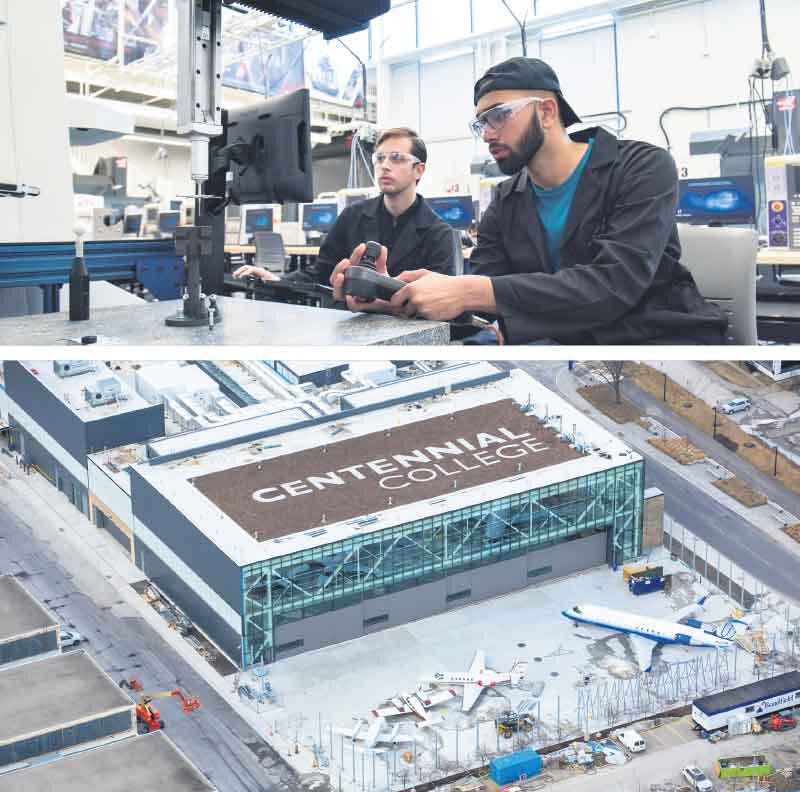Centennial College well set to support sector’s vision
Centennial College Aerospace Manufacturing students Kosta Dimopoulos (left) and Abdullah Hussain at a lab workstation at the college’s Downsview campus. Bottom, Centennial College’s $72-million Downsview campus repurposes an historic de Havilland building to create new classrooms, labs and workshops, along with two aircraft hangars. Centennial College
Canada’s aerospace industry is hoping all parties in the new parliament will work together to implement a bold plan to reinvigorate a sector at risk of losing its share of global aerospace growth to industries in countries with high levels of government support, planning and investment.
The Aerospace Industries Association of Canada’s (AIAC) Vision 2025 report recommends six key priorities for prosperity and several areas for further collaboration that Canada’s government and aerospace industry partners must take to continue to be a leader in an increasingly fierce competitive global economy.
“Canadian aerospace plays a major role in the economic health of our nation. Our industry has achieved many accomplishments, but that did not happen by accident,” Vision 2025 chair and former Quebec Premier Jean Charest commented when the report was released earlier this year. “It happened because government and industry shared a vision, worked and invested together. We need to renew that commitment today.”
It’s a call that Toronto’s Centennial College takes to heart.
“Our primary objective is to foster the partnerships between educational institutions, government and aerospace companies that will support the 50,000 graduates required by the Canadian aerospace industry as outlined in Vision 2025,” says Professor Jakub Szczepanski, program coordinator, Aerospace Manufacturing Engineering Technology, Centennial College.
“We have committed to launching and supporting both summer internships and co-op placements with Ontario aerospace companies,” he says. “We feel this close connection with industry serves our students, as well as providing Canadian companies with direct access to skilled candidates as they complete their education.”
The college is focused on reducing the skills gap that could hamper industry growth, and took the extraordinary step of relocating its aerospace programs from Scarborough to Downsview Park in Toronto.
The $72-million Downsview campus repurposes a historic de Havilland building to create new classrooms, labs and workshops, along with two aircraft hangars. It anchors Toronto’s aerospace hub together with the college’s partners in the Downsview Aerospace Innovation and Research consortium (DAIR), including Ryerson University, York University and University of Toronto (UTIAS), as well as leading companies such as Bombardier, Safran, Lynch Dynamics and Marsh Brothers.
“Our faculty and staff emphasize the exciting realities of a rewarding, well-paid and in-demand career in aerospace manufacturing,” says Prof. Szczepanski. “Gone are the days of dark, dangerous or dirty plants. Our graduates work in state-of-the-art, innovative and safe manufacturing facilities that require highly skilled employees.”
Through a partnership with Bombardier, the college has direct industry involvement in program curriculum development. Key Bombardier employees are members of the Program Advisory Committee, and their voices emphasize which skills and knowledge sets should be taught and assessed, which helps Centennial stay current on emerging industry technologies and required skill sets, adds Prof. Szczepanski.
Driving innovation through research partnerships with industry and incorporating knowledge gained is one of the college’s mandates. In one example, Centennial received funding from Natural Resources and Engineering Research Council of Canada (NSERC) to investigate electric actuation of landing gear and overall weight reduction in aircraft to improve fuel efficiency. Aerial drones provide another opportunity.
“We view the Unmanned Aerial Vehicle or drone sector as an area poised for extraordinary growth in the near future. To that end, we are equipping our students with hands-on knowledge of UAV control systems, mechanical design and testing, as well as new application scenarios,” says Prof. Szczepanski.
Composites and additive manufacturing are also disciplines graduates are exposed to throughout the program, which makes use of a sophisticated autoclave on campus.
“Currently, some commercial aircraft are composed of 50 per cent composite materials, and we see that percentage increasing. Also, more and more 3D printed parts are being used for non-structural aircraft components. Our graduates will leave knowing the emerging options available to them when joining Canadian aerospace companies,” he says.
For more stories from this feature, visit globeandmail.com


